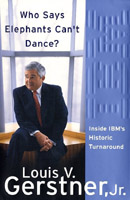In the foreword of Who Says Elephants Can’t Dance?, Louis V. Gerstner Jr.’s memoir of his nine years as CEO of IBM, Gerstner confesses that he isn’t one for reading the kind of book he’s written. After a twelve-hour day at work, he asks, “who would want to go home and read about someone else’s career at the office?”
The answer, as he apparently concluded (or was persuaded by the publisher) , is anyone who has ever said – or longed to say – “guess I showed you.”
Gerstner happily quotes the doom-laden predictions about IBM’s future that were prevalent when he took over as CEO in 1993, a year the company posted an $8 billion loss, and IBM shares that had sold for $43 in 1987 could be had for $12. IBM’s “prospects for survival are very bleak,” wrote the authors of the book Computer Wars. The Economist doubted whether “a company of IBM’s size, however organized, can ever react quickly enough to compete.” And Larry Ellison of Oracle commented: “IBM? We don’t even think about those guys anymore. They’re not dead, but they’re irrelevant.”
But, of course, Gerstner – and IBM – showed ’em. The book’s sub-title is Inside IBM’s Historic Turnaround and it’s fun reading Gerstner’s take on how that came about. He declined the job when it was first offered, he says, because he felt he didn’t have the technical know-how to handle it. But it turned out that his most important decisions weren’t based on technology but on his past experiences as an IBM customer.
In 1993, more than 90% of IBM’s profit came from its mainframe sales, which were sinking fast. Conventional wisdom had it that the main frame was simply losing out to personal computers. But Gerstner’s 11 years as head of American Express’s travel-related services division told him otherwise.
You can’t run a world-wide credit card business on a PC. You can’t run an airline on a PC. Main frames were still needed. IBM’s problem, he learned, was not product but price. He asked why the company hadn’t lowered its prices to meet the competition. “Because we’ll lose substantial revenues and profits when we need them badly,” he was told. Not exactly long-term thinking. “Get me a price reduction plan in two weeks,” he said.
Plans to break up IBM into smaller, supposedly more nimble businesses were well underway when Gerstner arrived. That made no sense to him as a former customer, he said. It was true that customers no longer wanted to be locked into a single supplier like IBM for all their information technology needs. But neither did they relish the task of picking and choosing from among thousands of suppliers to build a working system. “At the end of the day, in every industry, there’s an integrator,” Gerstner writes. And he felt that IBM, with its size and reach, was uniquely positioned to fill that role.
Gerstner calls his decision to keep IBM together “the most important decision I ever made – not just at IBM, but in my entire business career.” Yet he also makes it clear that it was one of the easiest.
For Gerstner the toughest challenge he faced in rejuvenating IBM – and the subject of most of his book – was changing the IBM culture. “Culture isn’t just one aspect of the game,” he writes. “It is the game. What does the culture reward and punish – individual achievement or team play, risk taking or consensus building?”
When he arrived, he found a company totally focused on its internal rules and conflicts. “Units competed with each other, hid things from each other. Huge staffs spent countless hours debating and managing transfer pricing terms between IBM units instead of facilitating a seamless transfer of products to customers.”
He found he was presiding over a world-wide collection of powerful fiefdoms, each one jealously guarding its own privileges and prerogatives. He discovered that European employees weren’t receiving his e-mails because the head of IBM-Europe was intercepting them. The exec had deemed the messages “inappropriate for his employees.” Gerstner summoned the exec to Armonk to inform him that those employees he presumed to protect didn’t belong to him, but to IBM.
Gerstner found a company that was operating as if IBM still ruled the computer world. And he’d had personal experience with what that could mean to customers. When he was at American Express, Gerstner recalled, an IBM representative withdrew all support for a massive credit card data center because the manager there had installed a single Amdahl computer in a facility that previously had been 100% IBM-equipped. When Gerstner arrived at IBM, he discovered that IBM, not Microsoft, was the biggest software company in the world, but none of the software IBM sold worked with anything other than IBM hardware.
Gerstner got a lot of publicity for abolishing IBM’s famous white shirt and tie dress code, but that was the least of his change-the-culture efforts. He launched IBM on its successful strategy of offering “solutions” to customers that, in violation of historic IBM tradition, might well include hardware and software manufactured by IBM competitors. He committed IBM to open standards so that its products could be used by competitors and vice versa. He decided that providing computing services – “transfer your IT operations to us” – was more important to IBM’s future than providing hardware.
None of this went down easily.
“Changing the attitude and behavior of thousands of people is very, very hard to accomplish,” Gerstner writes. “You can’t simply give a couple of speeches or write a new credo for the company and declare that a new culture has taken hold. You can’t mandate it, can’t engineer it. What you can do is create the conditions for transformation, provide incentives.”
Gerstner sent out a steady stream of e-mails to IBM employees to keep them posted about what was going on. (He includes a sampling of those communications in an appendix.) He changed the compensation system so that rewards were based on total corporate performance rather than division or unit performance. He changed the rules for getting promotions.
Gerstner tells of asking one of IBM’s most senior executives to give him a detailed analysis of a money losing business. Three days later, when he asked about it, the exec said: “I’ll check with the team and get back to you.” After two more similar responses, Gerstner told the exec: “Why don’t you just give me the name of the person doing the work. I’ll speak directly to him.” He explains that senior executives at IBM were expected to preside, to review. They didn’t do the work. Of course, he changed that, too.
Gerstner, who stepped down as CEO in March and retires as chairman of the board in January, says he was lucky at IBM because, despite its insular culture, the place was rich with creative talent that only needed to be set loose. He notes that the head of every major business unit today is a long-time IBMer, as is his successor as CEO, Sal Palmisano.
Mixed in with memories of IBM are Gerstner’s opinions on such subjects as investment bankers. He dislikes them. “They make money coming and going. They make huge fees telling AT&T to buy up everything in sight, then make more huge fees helping AT&T sell off everything.” He loses no opportunity to snipe at Microsoft. He relates how Bill Gates “wasn’t happy” when an IBM security guard failed to recognize him and gave him the wrong identity badge.
There are critics who say that IBM’s turnaround isn’t as terrific as Gerstner would have you think (even though last year’s profits were $8 billion), because revenue was boosted by a controversial switch in the IBM pension plan and the stock price was inflated by a major buyback effort, neither of which is mentioned in the book. The book also doesn’t delve into failed efforts, like education software.
But, then, this is Gerstner’s book and it seems only fair that he should be free to tell it his way. After all, he’s the elephant trainer who proved the dancing ability of a corporate behemoth that had to climb out of a multi-billion dollar hole just to get to the dance floor.



